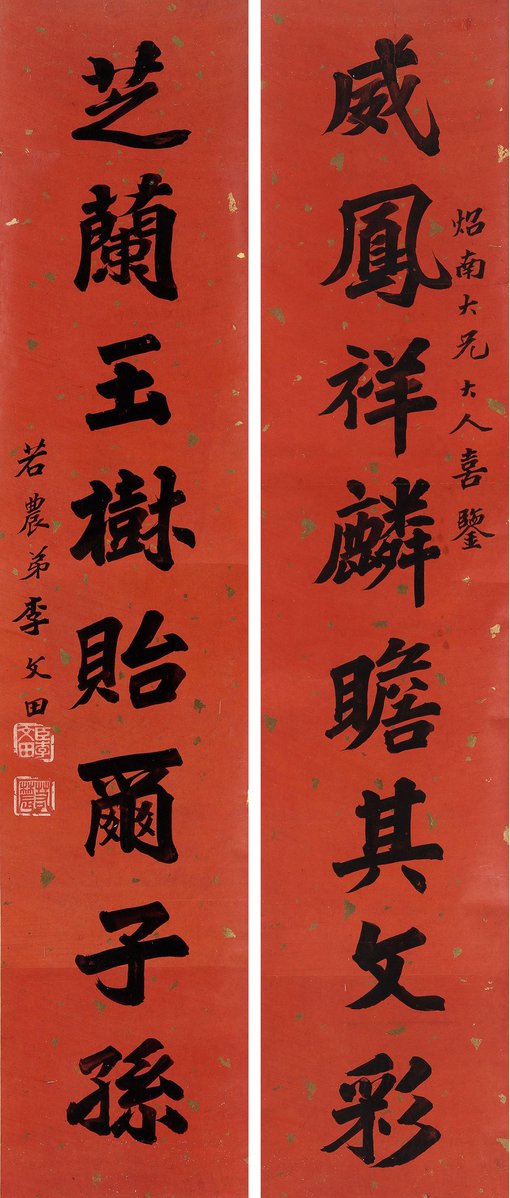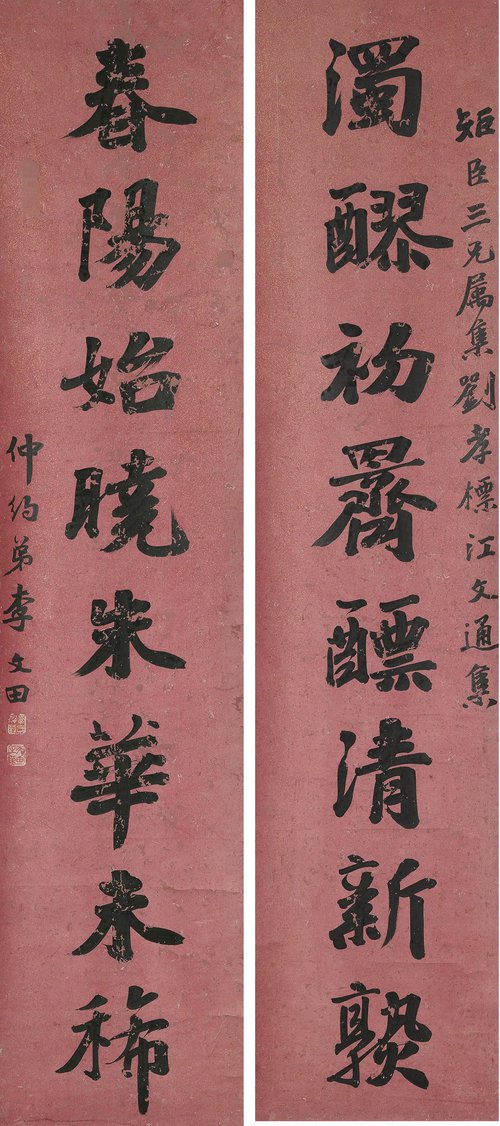

-
Details
- Place where the work was made
-
China
- Period
- Qing dynasty 1644 - 1911 → China
- Media categories
- Scroll , Calligraphy
- Materials used
- pair of hanging scrolls; ink on paper
- Dimensions
-
a - right scroll, 159 x 33.8 cm, image
a - right scroll, 204.5 x 41 cm, scroll
b - left scroll, 159 x 33.8 cm, image
b - left scroll, 204.5 x 41 cm, scroll
- Signature & date
Signed c.l. part b, in Chinese, inscribed in black ink "... Ruolong, Di Li Wentian".
Signed l.l. part b, in Chinese, stamped in red ink “Chen Li Wentian [artist's seal]".
Signed l.l. part b, in Chinese, stamped in red ink “Ruolong [artist's seal]".
Not dated.- Credit
- Gift of Dr. James Hayes 2003
- Location
- Not on display
- Accession number
- 277.2003.a-b
- Copyright
- Artist information
-
Li Wentian
Works in the collection
- Share
-
-
About
‘[Your] literary talent and grace are as majestic as the phoenix and as auspicious as the unicorn;
[Your] descendants will benefit and ‘flourish in the courtyard’ like magic mushrooms and fragrant orchids.’
Inscription and signature: For the joyful appraisal of Mr Zhaonan. Li Wentian, style name Ruonong.The expressions ‘phoenix feather’ and ‘unicorn’s horn’ symbolically hint at the notion of great genius. The references to fungus and orchid in the second line allude to an anecdote about Xie Xuan (343–88), the gifted military strategist and poet of the Eastern Jin dynasty. The story tells of how when Xie was a boy, he was once asked by his uncle what would be the most suitable way to raise children. Xie replied, ‘They should be given the opportunity to grow in a courtyard like fungus, orchid or the jade tree’. Xie was implying that just like the evolution of these auspicious plants, the nobility and glory of the family would carry on generation after generation. The grouping of ‘fungus, orchid and jade tree’ later became the metaphor for gifted children in a family. As such the couplet would be a suitable tribute to congratulate a scholar-official’s achievements, both his scholarship and the prosperity brought to the family line. Its visual appeal is enhanced by the material Li used – the red paper with scattered gilding reinforces the auspicious allusions of the poem.
Li Wentian (alias Sheguang, style name Ruonong) was a native of Shunde in Guangdong. At the age of 26, he received his ‘jinshi’ degree (granted title of ‘tanhua’ – third place) and assumed the position of a compiler at the Hanlin Academy. He served as the educational commissioner in Jiangxi and Zhili (present-day Hebei), as the chief examiner in Jiangsu and Zhejiang, vice-president of the Board of Ceremonies and during his years of absence from the court (having taken leave to look after his ill mother), he taught in Guangzhou. His students included Cai Yuanpei (1868–1940), the eminent educator and former chancellor of Peking University (1).
Li was also an eminent historian. His outstanding scholarship included his research into Mongolian history and the geography of north-western China. He was also recognised during his time as an important scholar in the stele studies (‘beixue’) movement. During the late Qing, ‘beixue’ overshadowed the previously prevalent ‘tiexue’ which was based on the study of classical calligraphy models. Scholar-calligraphers did not only collect, study and catalogue inscriptions taken from stone carvings of the Northern Wei, but also adopted and merged the elements of these calligraphies into their own calligraphic practice. Li Wentian was one of the most influential advocates of the Northern Wei stele style, condemning the more conventional style of ‘tiexue’. Li himself had an extensive collection of stele rubbings from the Qin to the Yuan dynasties period (3rd BCE–14th centuries). His assiduous absorption of early stele models produced a very distinctive style in the history of Chinese calligraphy, as demonstrated in this couplet.
1 See Ke, Shaoming, et al. 1977, ‘Biography 228’ in ‘History of the Qing dynasty (Qing shigao)’, Zhonghua Press, Beijing; Hummel, W. Arthur (ed). 1943 ‘Eminent Chinese of the Ch’ing period, United States Government Printing Office, Washington, pp.494–95.
‘The Poetic Mandarin: Chinese Calligraphy from the James Hayes Collection’. pg.82.
© 2005 Art Gallery of New South WalesThe couplet, written on two narrow pieces of paper or silk, and hung either side of a large painting or doorway, is one of the most common forms of calligraphic art and has a long standing history in China. They first appeared in the Five Dynasties period (907-979) as pairs of plaques, carved after written master copies, to decorate architectural columns, courtyards and garden doorways. Couplets for indoor display, written on paper or silk, came into existence in the 17th century and gained great popularity in the Qing dynasty. The couplets themselves are either taken from classical poetry or contemporary literary works composed by the calligraphers themselves and their friends. A couplet is made up of two parts called the head and the tail. The two lines of verse are antithetically parallel. Formerly it was a very common practice to send them to friends or relations on such occasions as marriages and birthdays, or as condolences to families of deceased persons.
Asian Art Department, AGNSW, August 2003.
-
Places
Where the work was made
China
-
Exhibition history
Shown in 1 exhibition
The poetic mandarin: Chinese calligraphy from the James Hayes collection, Art Gallery of New South Wales, Sydney, 23 Sep 2005–27 Nov 2005
-
Bibliography
Referenced in 3 publications
-
Sue Green, South China Morning Post, 'Scrolled gold', pg. 8, Hong Kong, 30 Oct 2005, 8 (illus.).
-
Jill Sykes (Editor), Look, Sydney, Sep 2005, cover (colour illus.), 7 (colour illus.). The colour illus. on cover is a detail of this work.
-
LIU Yang, The poetic mandarin: Chinese calligraphy from the James Hayes collection, Sydney, 2005, 82, 83 (illus.). cat.no. 19
-

